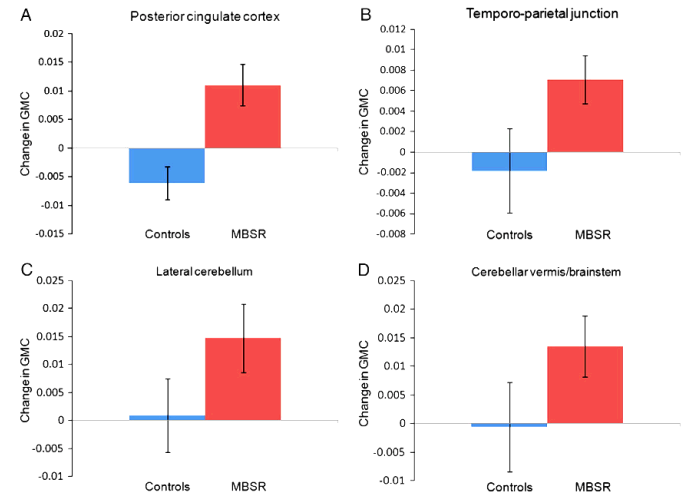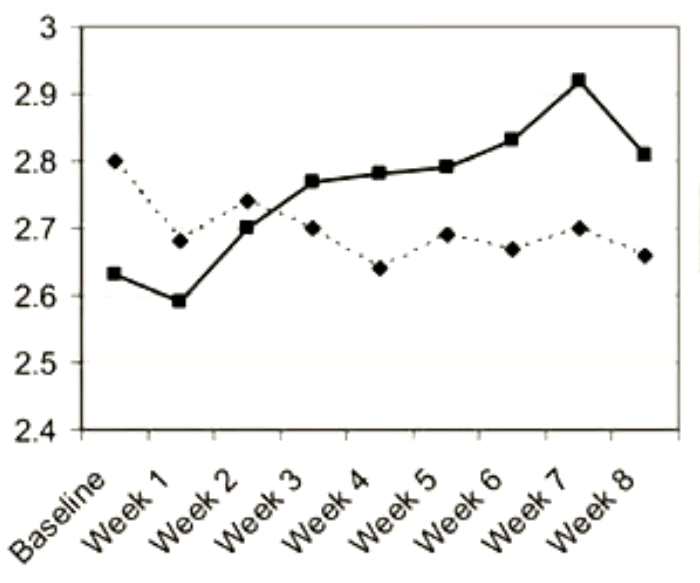Meditation
Meditation is particularly important for our Metal element, due to its link to the breath, and the stability it supports in the face of life’s challenges. The foundation of mindful meditation is being able to maintain awareness of our breath, our inner processes and eventually our thoughts and emotions. To do this we need to learn to control our human tendency towards mind-wandering. The following studies look at the effects of mind-wandering and show the impact meditation practice has on it.
Killingsworth, M. and Gilbert, D.T., (2010) A Wandering Mind Is an Unhappy Mind.
This study examined the link between mind-wandering and happiness. This research defined mind wandering as:
“a shift in the content of thought away from an ongoing task and/or from events in the external environment to self-generated thought and feelings.”(The Science of Wellbeing, 2018)
To discover the Impacts of mind-wandering the researcher used an app to ask 2250 people the following question throughout the day
“What are you doing?”
“Are you thinking about what you are currently doing?”
“Are you happy?”
Detailed results are shown in the image below:

Figure. 1. The Top section shows the mean happiness reported during each activity (top) [Higher number indicates greater happiness] The bottom section shows mean happiness while mind wandering to unpleasant topics, neutral topics, pleasant topics or not mind wandering. The dashed line indicates the mean of happiness across all samples. Bubble size indicates the frequency of occurrence. The largest bubble (“not mind wandering”) corresponds to 53.1% of the samples, and the smallest bubble (“praying/worshipping/meditating”) corresponds to 0.1% of the sample (Killingsworth and Gilbert, 2010).
Conclusions:
People mind-wander 46.9% of waking hours
People mind-wander 30% of the time in almost all activities (except sex)
Mind-wandering had a negative impact on happiness
Brewer, et al., (2011) Meditation experience is associated with differences in default mode network activity and connectivity.
Neuroscience has shown, through brain imaging, that when our mind wanders we fall into the Default Mode Network (DMN). Essentially we move out of the here and now to think about the past, the future or, about other minds (and what they think of us) (Mason et al., 2007).
This study compared expert meditators (with 10 000+ hrs of meditation practice) to controls and used brain imaging to measure activation of the Default Mode Network
Both groups did three kinds of meditation
Loving-kindness meditation (red)
Concentration on breath (blue)
Choiceless awareness (green)
Findings:

Figure 2. Experienced meditators demonstrate decreased DMN activation during meditation. Brain activation in meditators vs. controls is shown to be significantly lower across all meditations (relative to baseline). A and B show activations in the left medial prefrontal cortex (mPFC) and the posterior cingulate cortex (PCC) respectively. C and D show the average per cent signal change during individual meditation conditions in the mPFC and PCC respectively.
Conclusion:
Meditations can help to reduce mind-wandering. (Brewer et al., 2011)
Buddhism:
The Buddha says that when we are not present (when we are mind-wandering) we are in one of 4 states:
We are craving something from the past
We are experiencing aversion to something in the past
We are craving something in the future
We are experiencing aversion to something in the future
Pay attention and see if you agree with him.
Benefits of Meditation:
Hölzel et al. (2011) Mindfulness practice leads to increases in regional brain grey matter density.
In this paper, scientists measured grey matter in four different regions of the brain, before and after an 8-week mindfulness stress reduction course (MBSR)
Participants meditated on average for 27 mins a day
This was compared to a control group who did not take part in the course
Findings:

Figure 3. Change in grey matter concentrations within the four areas of the brain shown in A, B, C, and D compared to the control group. Error bars show a 95% confidence interval. (Hölzel et al., 2011)
Conclusion:
Meditation increased grey matter in all areas of the brain tested. Fredrickson et al. (2008) Open Hearts Build Lives: Positive Emotions, Induced Through Loving-Kindness Meditation, Build Consequential Personal Resources.
In this study, 202 participants were put into either a meditation or a control group (the control group was the wait list)
The meditation group engaged in 6 one-hour loving-kindness meditation sessions as a group over seven weeks
They were also asked to do guided mediations of 15-22 mins at least 5 days a week
Findings:

Figure 4: Showing the positive effects of meditation on mood
Conclusions:
Loving-kindness meditation improves positive emotions, leading to:
- Increased mindfulness
- Increased purpose in life
- Increased social support
- Decreased illness symptoms
(Fredrickson et al., 2008)
References
Aknin, L.B., Barrington-Leigh, C.P., Link to external site, this link will open in a new window, Dunn, E.W., Helliwell, J.F., Burns, J., Biswas-Diener, R., Kemeza, I., Nyende, P., Ashton-James, C.E. and Norton, M.I., (2013) Prosocial spending and well-being: Cross-cultural evidence for a psychological universal. Journal of Personality and Social Psychology, 1044, pp.635–652.
Alabdulgade, A., Maccraty, R., Atkinson, M., Vainoras, A., Berškienė, K., Mauricienė, V., Daunoravičienė, A., Navickas, Z., Šmidtaitė, R. and Landauskas, M., (2015) Human heart rhythm sensitivity to earth local magnetic field fluctuations. Journal of Vibroengineering, 176, pp.3271–3278.
Brewer, J.A., Worhunsky, P.D., Gray, J.R., Tang, Y.-Y., Weber, J. and Kober, H., (2011) Meditation experience is associated with differences in default mode network activity and connectivity. Proceedings of the National Academy of Sciences of the United States of America, 10850, pp.20254–20259.
Burbea, R., (2014) Seeing That Frees: Meditations on Emptiness and Dependent Arising. Troubador Publishing Ltd.
Dunn, E., Aknin, L.B. and Norton, M.I., (2008) Spending Money on Others Promotes Happiness. Science, [online] 3195870. Available at: https://www.researchgate.net/publication/5494996_Spending_Money_on_Others_Promotes_Happiness [Accessed 30 May 2022].
unn, E. and Norton, M., (2014) Happy Money: The New Science of Smarter Spending. Oneworld Publications.
Feng, G.-F. and English, J., (1975) Tao Te Ching: Lao Tsu. [online] London: Phoenix Books. Available at: https://www.amazon.co.uk/Tao-Te-Ching/dp/B003T73CVK/ref=sr_1_1?crid=QXHZE5OPVQ6A&keywords=tao+te+ching+gia-fu+feng&qid=1646076985&s=books&sprefix=tao+te+ching+gia-fu+feng%2Cstripbooks%2C127&sr=1-1 [Accessed 28 Feb. 2022].
Fredrickson, B.L., Cohn, M.A., Coffey, K.A., Pek, J. and Finkel, S.M., (2008) Open Hearts Build Lives: Positive Emotions, Induced Through Loving-Kindness Meditation, Build Consequential Personal Resources. Journal of personality and social psychology, 955, pp.1045–1062.
Harbaugh, W.T., Mayr, U. and Burghart, D.R., (2007) Neural Responses to Taxation and Voluntary Giving Reveal Motives for Charitable Donations. Science, 3165831, pp.1622–1625.
Harzer, C. and Ruch, W., (2012) When the job is a calling: The role of applying one’s signature strengths at work. The Journal of Positive Psychology, 75, pp.362–371.
Hölzel, B.K., Carmody, J., Vangel, M., Congleton, C., Yerramsetti, S.M., Gard, T. and Lazar, S.W., (2011) Mindfulness practice leads to increases in regional brain gray matter density. Psychiatry research, 1911, pp.36–43.
Kiken, L.G. and Shook, N.J., (2011) Looking Up: Mindfulness Increases Positive Judgments and Reduces Negativity Bias. Social Psychological and Personality Science, 24, pp.425–431.
Killingsworth, M. and Gilbert, D.T., (2010) A Wandering Mind Is an Unhappy Mind. 3306006, p.932.
Lavy, S. and Littman-Ovadia, H., (2017) My Better Self: Using Strengths at Work and Work Productivity, Organizational Citizenship Behavior, and Satisfaction. Journal of career development, 442, pp.95–109.
Mason, M.F., Norton, M.I., Van Horn, J.D., Wegner, D.M., Grafton, S.T. and Macrae, C.N., (2007) Wandering Minds:
The Default Network and Stimulus-Independent Thought. Science (New York, N.Y.), 3155810, pp.393–395.
Seligman, M.E.P., (2004) Authentic Happiness: Using the New Positive Psychology to Realize Your Potential for Lasting Fulfilment. Reprint edition ed. New York London Toronto Sydney New Delhi: Atria Books.
The Science of Wellbeing. (2018) Yale University.
Weinstein, N. and Ryan, R.M., (2010) When helping helps: autonomous motivation for prosocial behaviour and its influence on well-being for the helper and recipient. Journal of Personality and Social Psychology, 982, pp.222–244.
Zilli Vieira, C.L., Alvares, D., Blomberg, A., Schwartz, J., Coull, B., Huang, S. and Koutrakis, P., (2019) Geomagnetic disturbances driven by solar activity enhance total and cardiovascular mortality risk in 263 U.S. cities. Environmental health, 181, pp.83–83.
